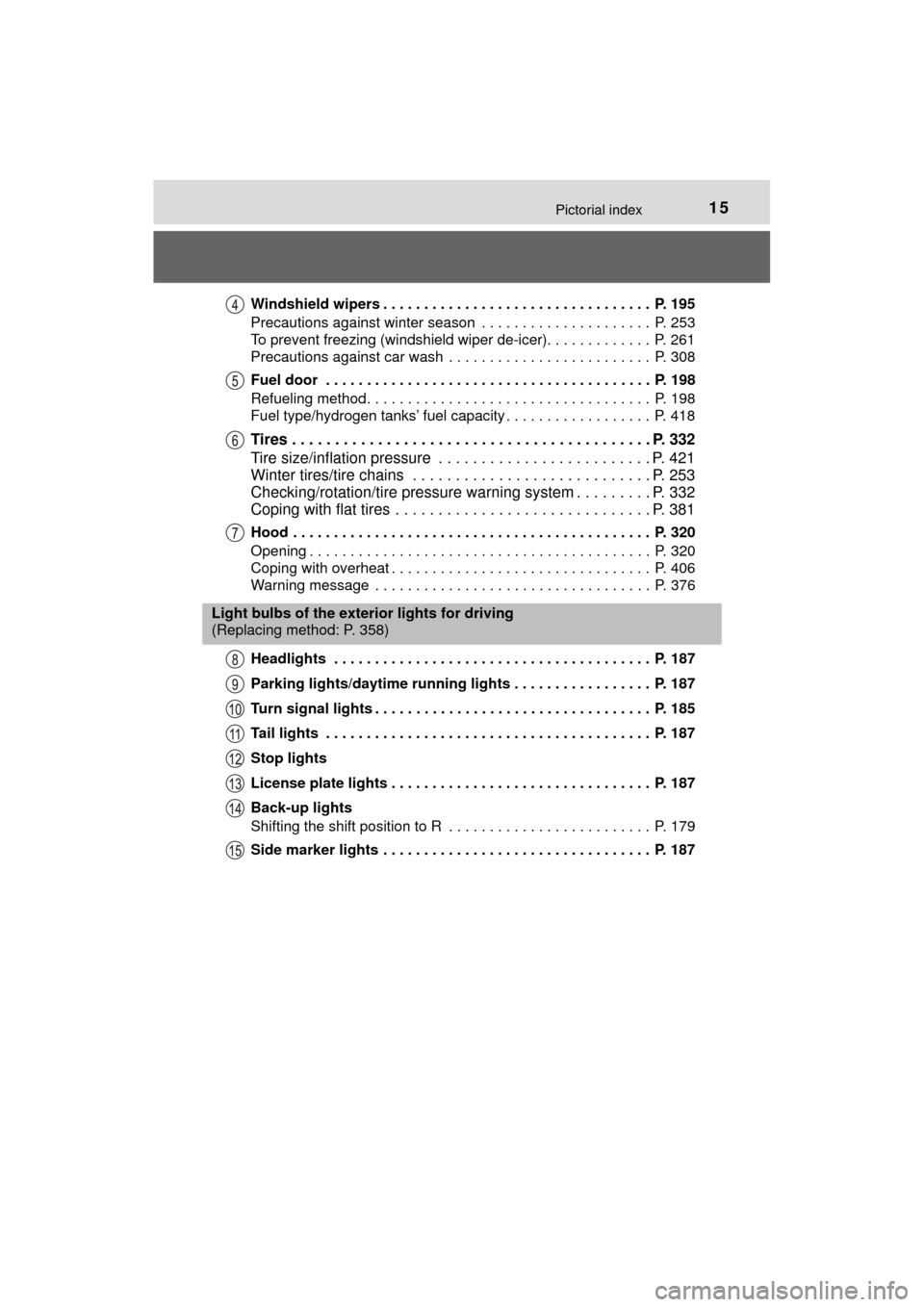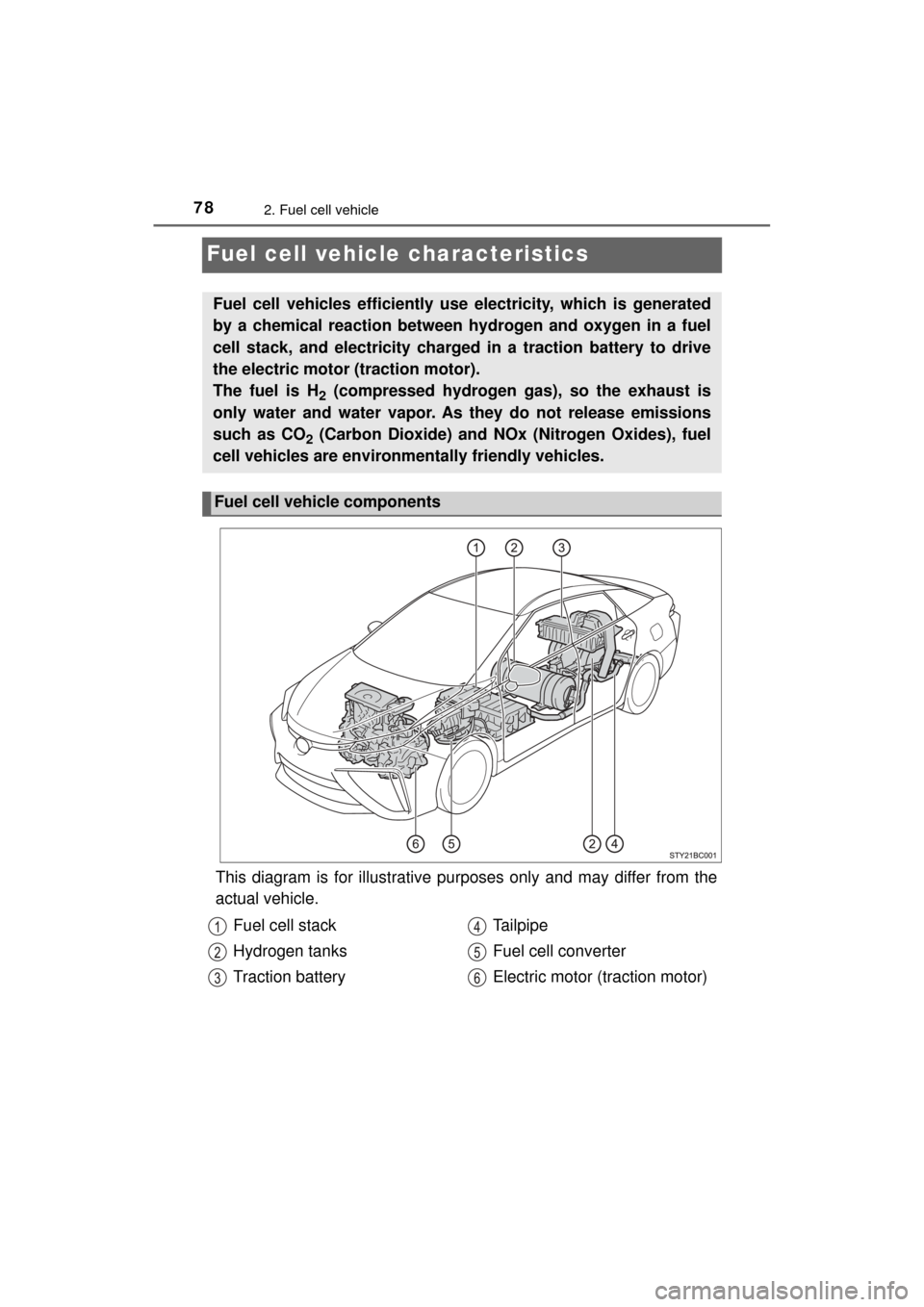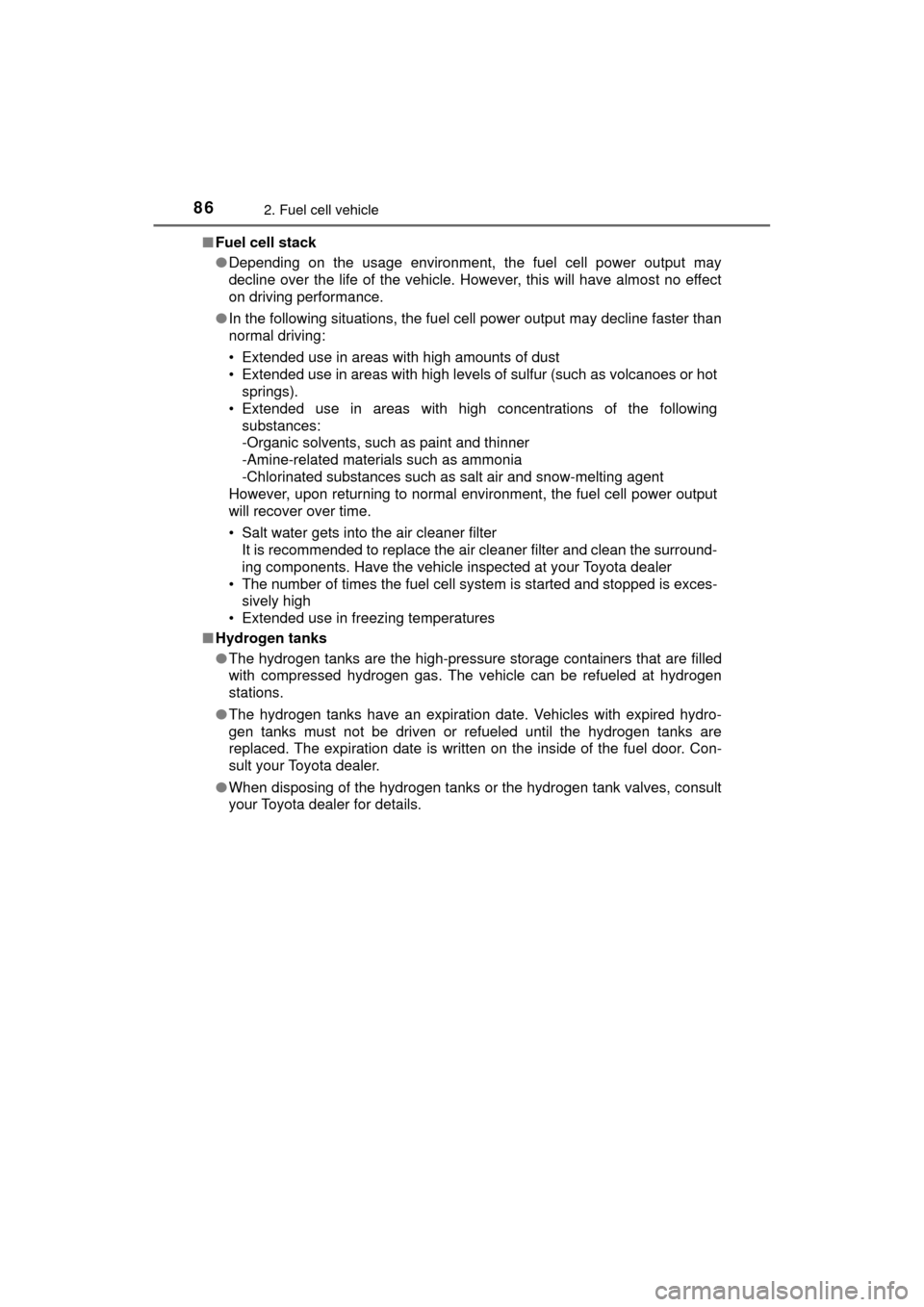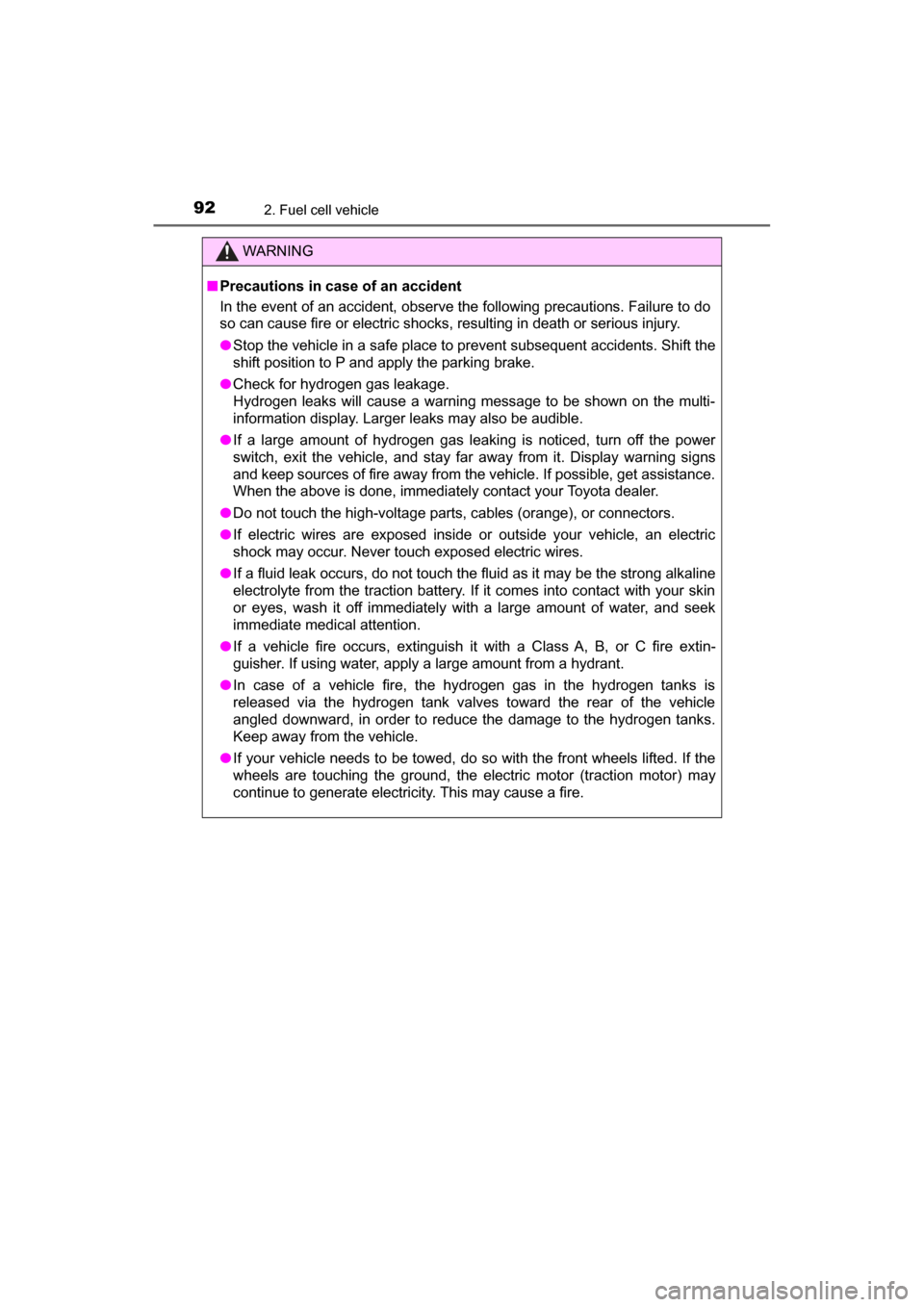2017 TOYOTA MIRAI tank
[x] Cancel search: tankPage 15 of 464

15Pictorial index
MIRAI_OM_USA_OM62023UWindshield wipers . . . . . . . . . . . . . . . . . . . . . . . . . . . . . . . . . P. 195
Precautions against winter season . . . . . . . . . . . . . . . . . . . . . P. 253
To prevent freezing (windshield wiper de-icer). . . . . . . . . . . . . P. 261
Precautions against car wash . . . . . . . . . . . . . . . . . . . . . . . . . P. 308
Fuel door . . . . . . . . . . . . . . . . . . . . . . . . . . . . . . . . . . . . . . . . P. 198
Refueling method . . . . . . . . . . . . . . . . . . . . . . . . . . . . . . . . . . . P. 198
Fuel type/hydrogen tanks’ fuel capacity . . . . . . . . . . . . . . . . . . P. 418
Tires . . . . . . . . . . . . . . . . . . . . . . . . . . . . . . . . . . . . . . . . . . P. 332
Tire size/inflation pressure . . . . . . . . . . . . . . . . . . . . . . . . . P. 421
Winter tires/tire chains . . . . . . . . . . . . . . . . . . . . . . . . . . . . P. 253
Checking/rotation/tire pressure warning system . . . . . . . . . P. 332
Coping with flat tires . . . . . . . . . . . . . . . . . . . . . . . . . . . . . . P. 381
Hood . . . . . . . . . . . . . . . . . . . . . . . . . . . . . . . . . . . . . . . . . . . . P. 320
Opening . . . . . . . . . . . . . . . . . . . . . . . . . . . . . . . . . . . . . . . . . . P. 320
Coping with overheat . . . . . . . . . . . . . . . . . . . . . . . . . . . . . . . . P. 406
Warning message . . . . . . . . . . . . . . . . . . . . . . . . . . . . . . . . . . P. 376
Headlights . . . . . . . . . . . . . . . . . . . . . . . . . . . . . . . . . . . . . . . P. 187
Parking lights/daytime running lights . . . . . . . . . . . . . . . . . P. 187
Turn signal lights . . . . . . . . . . . . . . . . . . . . . . . . . . . . . . . . . . P. 185
Tail lights . . . . . . . . . . . . . . . . . . . . . . . . . . . . . . . . . . . . . . . . P. 187
Stop lights
License plate lights . . . . . . . . . . . . . . . . . . . . . . . . . . . . . . . . P. 187
Back-up lights
Shifting the shift position to R . . . . . . . . . . . . . . . . . . . . . . . . . P. 179
Side marker lights . . . . . . . . . . . . . . . . . . . . . . . . . . . . . . . . . P. 187
Light bulbs of the exterior lights for driving
(Replacing method: P. 358)
Page 78 of 464

782. Fuel cell vehicle
MIRAI_OM_USA_OM62023U
Fuel cell vehicle characteristics
This diagram is for illustrative purposes only and may differ from the
actual vehicle.
Fuel cell vehicles efficiently use electricity, which is generated
by a chemical reaction between hydrogen and oxygen in a fuel
cell stack, and electricity charged in a traction battery to drive
the electric motor (traction motor).
The fuel is H
2 (compressed hydrogen gas), so the exhaust is
only water and water vapor. As they do not release emissions
such as CO
2 (Carbon Dioxide) and NOx (Nitrogen Oxides), fuel
cell vehicles are environm entally friendly vehicles.
Fuel cell vehicle components
Fuel cell stack
Hydrogen tanks
Traction battery Tailpipe
Fuel cell converter
Electric motor (traction motor)
Page 80 of 464

802. Fuel cell vehicle
MIRAI_OM_USA_OM62023U
■Sounds unique to the fuel cell vehicle
Due to the design of your fuel cell vehicle, there are various relays, valves
and pumps which under normal driving conditions will produce sounds. This
is a normal characteristic of the vehicle and does not indicate a malfunction.
Furthermore, way of hearing may differ based on usage environment or con-
dition.
Noticeable soundsSource of the sounds
Clunking, clicking and clack-
ingOperation of relays and hydrogen tank
valves
Sounds may come from under the floor or
behind the rear seats.
(Sounds may be heard when starting the
fuel cell system.)
KnockingThe parking lock is engaged
Sounds may come from the motor
compartment.
(Sounds may be heard when press the P
position switch or stopping the fuel cell
system.)
Whooshing, squealingGas is flowing through the nozzle and
valvesSounds may come from behind the rear
seats, or from the dispenser hose/nozzle.
(Sounds may be heard when filling the
fuel.)
• High pitch sound
• Gurgle sound
• Pulsing soundOperation of the pumpsSounds may come from the motor com-
partment or under the front seats.
(In particular, sounds may be heard when
starting the fuel cell system, accelerating
from a stop, or press the H
2O switch. The
sound may be louder when in Br mode or
when the vehicle decelerates during
dynamic radar cruise control.)
Humming soundOperation of the pumps are speeding up
Sounds may come from the motor com-
partment or under the front seats.
(In particular, sounds may be heard when
accelerating or decelerating.)
Whooshing sound Operation of the hydrogen injectorSounds may come from under the front
seats or behind the rear seats.
(In particular, sounds may be heard when
starting the fuel cell system, driving at low
speeds, or charging the traction battery.)
Page 82 of 464
![TOYOTA MIRAI 2017 1.G Owners Manual 822. Fuel cell vehicle
MIRAI_OM_USA_OM62023U
Fuel cell vehicle precautions
The fuel cell vehicle has hydrogen tanks (10150 psi [70 MPa,
714 kgf/cm2, 700 bar]), fuel cell stack, and hydrogen pipelines TOYOTA MIRAI 2017 1.G Owners Manual 822. Fuel cell vehicle
MIRAI_OM_USA_OM62023U
Fuel cell vehicle precautions
The fuel cell vehicle has hydrogen tanks (10150 psi [70 MPa,
714 kgf/cm2, 700 bar]), fuel cell stack, and hydrogen pipelines](/manual-img/14/6553/w960_6553-81.png)
822. Fuel cell vehicle
MIRAI_OM_USA_OM62023U
Fuel cell vehicle precautions
The fuel cell vehicle has hydrogen tanks (10150 psi [70 MPa,
714 kgf/cm2, 700 bar]), fuel cell stack, and hydrogen pipelines as
hydrogen-related components. Pay attention to all warning labels
attached to the vehicle.
This diagram is for illust rative purposes only and may differ from the
actual vehicle.
Hydrogen-related components
Warning label
Hydrogen detectors
Fuel cell stack Hydrogen tanks
Hydrogen tank valves
Hydrogen pipelines
Page 84 of 464

842. Fuel cell vehicle
MIRAI_OM_USA_OM62023U
When a certain level of impact from an accident is detected, the fuel
cell system is shut down and the system shuts out the high voltage.
Also, the fuel supply is stopped from the hydrogen tank valves. If the
emergency shut off system activates, your vehicle will not restart. To
restart the fuel cell system, contact your Toyota dealer.
A message is automatically displa yed when a malfunction occurs in
the fuel cell system or an im proper operation is attempted.
If a warning message is shown on
the multi-information display, read
the message and follow the
instructions. ( →P. 376)
Fuel cell vehicles do not have engi ne sounds like gasoline vehicles.
Therefore, it makes an artificial no ise at low speeds to notify pedestri-
ans and nearby vehicles that it is approaching. The sound varies with
speed and will stop when the v ehicle exceeds approximately 15 mph
(25 km/h).
Emergency shut off system
Fuel cell warning message
Vehicle proximity notification system
Page 86 of 464

862. Fuel cell vehicle
MIRAI_OM_USA_OM62023U■
Fuel cell stack
●Depending on the usage environment, the fuel cell power output may
decline over the life of the vehicle. However, this will have almost no effect
on driving performance.
● In the following situations, the fuel cell power output may decline faster than
normal driving:
• Extended use in areas with high amounts of dust
• Extended use in areas with high levels of sulfur (such as volcanoes or hot
springs).
• Extended use in areas with high concentrations of the following substances:
-Organic solvents, such as paint and thinner
-Amine-related materials such as ammonia
-Chlorinated substances such as salt air and snow-melting agent
However, upon returning to normal environment, the fuel cell power output
will recover over time.
• Salt water gets into the air cleaner filter It is recommended to replace the air cleaner filter and clean the surround-
ing components. Have the vehicle inspected at your Toyota dealer
• The number of times the fuel cell system is started and stopped is exces- sively high
• Extended use in freezing temperatures
■ Hydrogen tanks
●The hydrogen tanks are the high-pressure storage containers that are filled
with compressed hydrogen gas. The vehicle can be refueled at hydrogen
stations.
● The hydrogen tanks have an expiration date. Vehicles with expired hydro-
gen tanks must not be driven or refueled until the hydrogen tanks are
replaced. The expiration date is written on the inside of the fuel door. Con-
sult your Toyota dealer.
● When disposing of the hydrogen tanks or the hydrogen tank valves, consult
your Toyota dealer for details.
Page 90 of 464

902. Fuel cell vehicle
MIRAI_OM_USA_OM62023U■
Basic concepts of hydrogen safety
●Prevent leakage
The pipe joints of the hydrogen pipelines are designed to prevent leaks.
The joints are checked for gas leakage at every official vehicle inspection.
● Detect to stop leakage
• The vehicle is equipped with hydrogen detectors. If the hydrogen detec-
tors detect a leak, the hydrogen tank valves automatically close to pre-
vent more hydrogen from escaping.
• The vehicle is equipped with a collision sensor. If the collision sensor
detects a collision, the hydrogen tank valves automatically close to pre-
vent hydrogen gas from leaking from any damaged components.
● Disperse the leaked hydrogen gas
The hydrogen tanks and pipelines are located outside of the passenger
compartment, so any leaked gas will disperse into the atmosphere by
design.
● Eliminate sources of fire
No source of fire is located near the hydrogen pipelines by design.
WARNING
■Hydrogen-related components
● Never alter, customize, or disassemble any hydrogen-related parts.
● The hydrogen tanks, fuel cell stack, hydrogen pipelines, and connecting
components are filled with hydrogen gas. Do not remove or disassemble
these parts. Doing so can cause a hydrogen gas leak, resulting in fire or
explosion of the vehicle, which may result in death or serious injury.
■ When hydrogen gas leak or other malfunction is detected
● If you notice gas leaking noises or any other malfunction, immediately stop
the vehicle in a safe, well-ventilated place.
● If a warning message is shown on the multi-information display, immedi-
ately stop the vehicle in a safe, well-ventilated place.
● If a large amount of hydrogen gas leaking is noticed, turn off the power
switch, exit the vehicle, and stay far away from it. Display warning signs
and keep sources of fire away from the vehicle. If possible, get assistance.
When the above is done, immediately contact your Toyota dealer.
Page 92 of 464

922. Fuel cell vehicle
MIRAI_OM_USA_OM62023U
WARNING
■Precautions in case of an accident
In the event of an accident, observe the following precautions. Failure to do
so can cause fire or electric shocks, resulting in death or serious injury.
● Stop the vehicle in a safe place to prevent subsequent accidents. Shift the
shift position to P and apply the parking brake.
● Check for hydrogen gas leakage.
Hydrogen leaks will cause a warning message to be shown on the multi-
information display. Larger leaks may also be audible.
● If a large amount of hydrogen gas leaking is noticed, turn off the power
switch, exit the vehicle, and stay far away from it. Display warning signs
and keep sources of fire away from the vehicle. If possible, get assistance.
When the above is done, immediately contact your Toyota dealer.
● Do not touch the high-voltage parts, cables (orange), or connectors.
● If electric wires are exposed inside or outside your vehicle, an electric
shock may occur. Never touch exposed electric wires.
● If a fluid leak occurs, do not touch the fluid as it may be the strong alkaline
electrolyte from the traction battery. If it comes into contact with your skin
or eyes, wash it off immediately with a large amount of water, and seek
immediate medical attention.
● If a vehicle fire occurs, extinguish it with a Class A, B, or C fire extin-
guisher. If using water, apply a large amount from a hydrant.
● In case of a vehicle fire, the hydrogen gas in the hydrogen tanks is
released via the hydrogen tank valves toward the rear of the vehicle
angled downward, in order to reduce the damage to the hydrogen tanks.
Keep away from the vehicle.
● If your vehicle needs to be towed, do so with the front wheels lifted. If the
wheels are touching the ground, the electric motor (traction motor) may
continue to generate electricity. This may cause a fire.